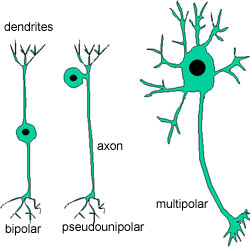
Neurons (Nerve cells) are specialised cells that conduct electrical impulses.
All neurons have the same basic structure:
- Dendrites extend from the cell body (dendron - greek for tree). These are fairly short, with lots of branches, and they are the points at which nerve impulses are received by the cell.
- The cell body (perikaryon). Most of the cell bodies of neurons are in the central nervous system (brain and spinal cord), or in the ganglia (which lie just outside the spinal cord) of the peripheral nervous system.
- The axon: a single nerve 'fibre' which transmits impulses to the distal end. Axons can be very long - around 1 metre, and vary in diameter from 0.2 to 20 µm
The red arrows show the direction of nerve impulse transmission.
As well as conducting electrical impulses, the cell has to transport proteins, lipids, and other macromolecules, from the cell body to the synapses (anterograde direction), because all of the protein making machinery (ribosomes, endoplasmic reticulum) is in the cell body. This is known as axonal transport. There is a slow transport system of a few millimetres a day, and a fast system, which is about 100 times faster. There is also retrograde flow, in which unused or recycled constituents are returned to the cell body.
(Fast anterograde flow involves microtubules, and the microtubule motor protein called kinesin.)

